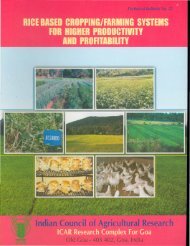Nutrition of Common Freshwater Ornamental Fishes
Nutrition of Common Freshwater Ornamental Fishes
Nutrition of Common Freshwater Ornamental Fishes
You also want an ePaper? Increase the reach of your titles
YUMPU automatically turns print PDFs into web optimized ePapers that Google loves.
Chapter-VI<br />
Nutrient requirement and diet development<br />
<strong>of</strong> guppy, Poecilia reticulata.<br />
Guppy is a favourite and prized live bearing fish. It is one <strong>of</strong> the most traded ornamental<br />
fish. There are more than 50 pure and cross bred varieties <strong>of</strong> guppy are available<br />
in the market and among them the most important varieties are grass, king cobra,<br />
peacock, mosaic and tuxedo. Guppy is compatible to other fish and therefore, can be<br />
reared in community tank. It can grow 2-3 inch in size and takes 4-5 months to get<br />
matured and can breed 8-10 times in a year. The life span <strong>of</strong> guppy is one and half<br />
to two years. It eats on mosquito larvae and thereby used in controlling the malaria.<br />
It is a very hardy fish and withstands wide fluctuations <strong>of</strong> water quality parameters.<br />
As guppy contribute about 20 to 25 per cent <strong>of</strong> the ornamental fish trade, it is very<br />
much essential to formulate the cost-effective practical diets based on the nutrient<br />
requirement <strong>of</strong> fish. Therefore, the study on nutrient requirement <strong>of</strong> this fish was<br />
attempted so as to formulate the cost-effective nutritionally balanced practical diets.<br />
To determine the protein and lipid requirement <strong>of</strong> guppy, Poecilia reticulata, nine<br />
iso-caloric (3.5 kcal/g) purified diets (casein-gelatin-dextrin based) were prepared<br />
taking three levels <strong>of</strong> protein (30, 35 and 40 %) and three levels <strong>of</strong> lipid (6, 8 and<br />
10 %) as indicated in Tables 24 and 25. Each experimental diet was fed in triplicate<br />
tanks (100 I capacity with 40 I water) in an indoor static water system. In each tank,<br />
10 healthy fingerlings were stocked and the fish were fed ad libitum for a period <strong>of</strong><br />
60 days. The seasoned tap water was used as rearing medium. The water temperature<br />
was recorded daily at 09.30 and 14.30 h <strong>of</strong> the day and other water quality parameters<br />
were analysed in every 15 days interval. The fish were batch weighed in every 15<br />
days to know the growth and general health status <strong>of</strong> the fish. The growth and nutrient<br />
utilization <strong>of</strong> fish was significantly better (p



